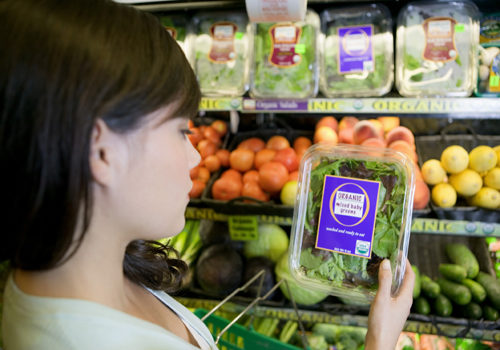
You buy organic and natural foods every week. But do you know the difference between the two? Here’s a primer about what the terms mean (and don’t mean).
What Is Organic?
The U.S. Department of Agriculture (USDA) has created specific standards that all organic farmers, ranchers and food processors must follow to ensure that the product meets organic principles. The standards and organic principles cover the product from “farm to table,” covering several items such as soil and water quality, livestock practices, pest control and food additives (1).
Organic food shoppers can expect their groceries to be minimally processed and made without synthetic materials, such as toxic pesticides, synthetic fertilizers, genetic engineering and artificial colors, flavors and preservatives. In addition, sewage sludge and irradiation cannot be part of the organic farming process. Instead, organic farmers use crop rotation, mulch, weeding and cover crops to ensure the healthy growth of crops. Building healthy, nutrient-rich soil is a top priority. Livestock intended for use as organic food cannot be given antibiotics or synthetic hormones. Their feed must also be organic, and their living conditions should be clean and cage free with access to the outdoors (1).
By avoiding the use of any prohibited materials, organic farmers and food processors provide a thriving environment for their crops and livestock, and therefore, support the health and welfare of consumers and the environment.
While the USDA creates the rules for organic, approved third-party inspectors are the ones that visit facilities to ensure U.S. organic standards are met (1). To be “organic,” farmers, ranchers and food processors must be certified by these inspectors every three years. The cost of certification varies from a few hundred to several thousand dollars (2).
Another important thing to understand about organic certification is that there are several different levels. To obtain the USDA seal, which can be either green and white or black and white, the products must be certified 95% or more organic. Products that contain only certified organic ingredients may use the seal along with “100% Organic” verbiage.
Products that fall between 70% and 94% organic are only allowed to claim “Made with organic ingredients” on their packages. If a product contains 70% or less ingredients that are organic, the package may only list ingredient(s) that is/are organic on the ingredient list.
So, there are some exceptions to the organic rules. According to the USDA, certain allowable synthetic substances may be used in organic products. They are specified on The National List of Allowed and Prohibited Substances. Certain substances may only be used for specific situations, such as vaccines in livestock. Every five years, the National Organic Standards Board reviews all the substances from the National List to see which should stay on the list. Certain substances may be either added or asked to be removed through petitions that are directly sent to the USDA, which makes all petitions available online (1).
What’s on the list? It’s intended to cover items that are not available in an organic form or in industrial quantities and cannot be toxic to humans or the environment. Examples include vaccines for livestock, newspaper for mulch, baking soda, certain algae-derived ingredients and more.
Now, shoppers buying personal care products should know that “organic” certification only applies to foods. If a lip balm bears an organic seal, the product must abide by the food standards.
What Is Natural?
Many food products claim to be “natural” although no formal regulations have been developed by the U.S. Food and Drug Administration (FDA) yet. FDA has said that “natural” products should include nothing artificial or synthetic, but it doesn’t enforce this policy (1).
There is a lot of wiggle room with “natural,” in fact. Some products labeled “natural” may contain high-fructose corn syrup, for instance, a highly processed ingredient that is derived from natural sources. Responsible natural products retailers will ensure products on their shelves don’t include this and other potentially harmful ingredients that some food companies pass off as “natural.”
Certain groups have developed their own standards and certification for “natural.” The Natural Products Association (NPA), for instance, has programs in place for both personal care and home care products. Items bearing the NPA Natural Standard seal must use biodegradable ingredients, environmentally sensitive packaging, be made responsibly with no animal testing, not include any ingredients thought to pose a risk to humans and include only natural ingredients (4).
The issue of genetically modified materials is more difficult. While corn or canola oils may be considered “natural” by some standards, others believe that they are not since they likely contain genetically engineered material. Natural products stores may stock items verified as GMO free to avoid GMOs; or they may rely on certified organic foods since genetically engineered ingredients are prohibited by those standards. WF
See www.wholefoodsmagazine.com/columns/consumer-bulletin for other Consumer Bulletins.
References
1. Organic Trade Association, www.ota.com, accessed Feb. 25, 2015.
2. CCOF, www.ccof.org/certification/fees, accessed Feb. 25, 2015.
3. National Organic Program, http://www.ams.usda.gov/AMSv1.0/ams.
fetchTemplateData.do?template=TemplateJ&leftNav=NationalOrganicProgram&page=NOPNationalList&description=National%20List%20of%20Allowed%20and%20Prohibited%20Substances&acct=nopgeninfo, accessed Feb. 25, 2015.
4. Natural Products Association, www.npainfo.org/NPA/NaturalSealCertification/TheNaturalSeal.aspx, accessed Feb. 25, 2015.
Published in WholeFoods Magazine, April 2015










